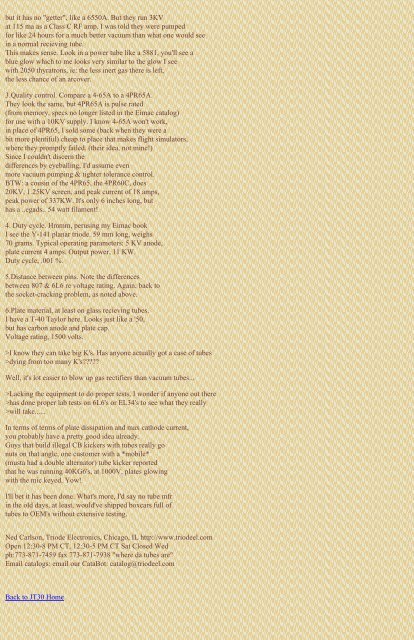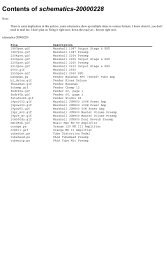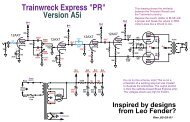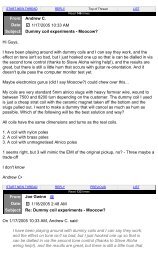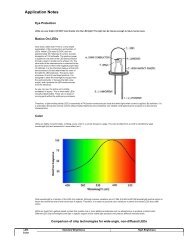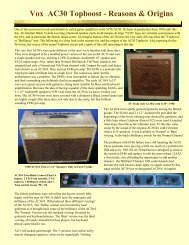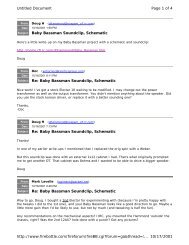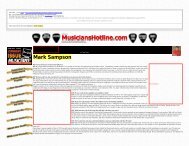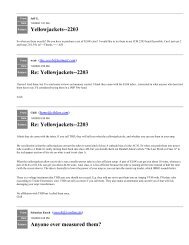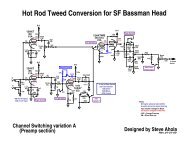Mic Kaczmarczik's TubeInformation - The Blue Guitar
Mic Kaczmarczik's TubeInformation - The Blue Guitar
Mic Kaczmarczik's TubeInformation - The Blue Guitar
Create successful ePaper yourself
Turn your PDF publications into a flip-book with our unique Google optimized e-Paper software.
ut it has no "getter", like a 6550A. But they run 3KV<br />
at 115 ma as a Class C RF amp. I was told they were pumped<br />
for like 24 hours for a much better vacuum than what one would see<br />
in a normal recieving tube.<br />
This makes sense. Look in a power tube like a 5881, you'll see a<br />
blue glow which to me looks very similar to the glow I see<br />
with 2050 thyratrons, ie: the less inert gas there is left,<br />
the less chance of an arcover.<br />
3.Quality control. Compare a 4-65A to a 4PR65A.<br />
<strong>The</strong>y look the same, but 4PR65A is pulse rated<br />
(from memory, specs no longer listed in the Eimac catalog)<br />
for use with a 10KV supply. I know 4-65A won't work,<br />
in place of 4PR65, I sold some (back when they were a<br />
bit more plentiful) cheap to place that makes flight simulators,<br />
where they promptly failed. (their idea, not mine!)<br />
Since I couldn't discern the<br />
differences by eyeballing, I'd assume even<br />
more vacuum pumping & tighter tolerance control.<br />
BTW: a cousin of the 4PR65, the 4PR60C, does<br />
20KV, 1.25KV screen, and peak current of 18 amps,<br />
peak power of 337KW. It's only 6 inches long, but<br />
has a ..egads.. 54 watt filament!<br />
4. Duty cycle. Hmmm, perusing my Eimac book<br />
I see the Y-141 planar triode. 59 mm long, weighs<br />
70 grams. Typical operating parameters: 5 KV anode,<br />
plate current 4 amps. Output power, 11 KW.<br />
Duty cycle, .001 %.<br />
5.Distance between pins. Note the differences<br />
between 807 & 6L6 re voltage rating. Again, back to<br />
the socket-cracking problem, as noted above.<br />
6.Plate material, at least on glass recieving tubes.<br />
I have a T-40 Taylor here. Looks just like a '50,<br />
but has carbon anode and plate cap.<br />
Voltage rating, 1500 volts.<br />
>I know they can take big K's. Has anyone actually got a case of tubes<br />
>dying from too many K's?????<br />
Well, it's lot easier to blow up gas rectifiers than vacuum tubes...<br />
>Lacking the equipment to do proper tests, I wonder if anyone out there<br />
>has done proper lab tests on 6L6's or EL34's to see what they really<br />
>will take......<br />
In terms of terms of plate dissipation and max cathode current,<br />
you probably have a pretty good idea already.<br />
Guys that build illegal CB kickers with tubes really go<br />
nuts on that angle, one customer with a *mobile*<br />
(musta had a double alternator) tube kicker reported<br />
that he was running 40KG6's, at 1000V, plates glowing<br />
with the mic keyed. Yow!<br />
I'll bet it has been done. What's more, I'd say no tube mfr<br />
in the old days, at least, would've shipped boxcars full of<br />
tubes to OEM's without extensive testing.<br />
Ned Carlson, Triode Electronics, Chicago, IL http://www.triodeel.com<br />
Open 12:30-8 PM CT, 12:30-5 PM CT Sat Closed Wed<br />
ph:773-871-7459 fax 773-871-7938 "where da tubes are"<br />
Email catalogs: email our CataBot: catalog@triodeel.com<br />
Back to JT30 Home


